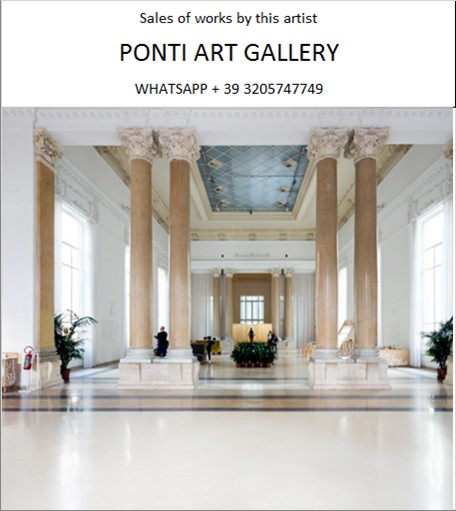Ponti Art Gallery is interested in buying and selling works
of art by this artist.

Antonio Dias Biography
Antonio Manuel Lima Dias, commonly known as Antonio Dias, was a Brazilian artist and graphic designer born on February 22, 1944, in Campina Grande, Paraíba, Brazil. He emerged as a significant figure in the Brazilian and international art scenes, known for his multifaceted approach to art that spanned painting, sculpture, installations, and video art. Dias' work is celebrated for its political engagement, conceptual depth, and formal innovation, making him one of the most influential Brazilian artists of his generation.
Dias' family moved from Campina Grande to Rio de Janeiro in 1957, a period marked by Brazil's rapid modernization under President Juscelino Kubitschek's ambitious plan to achieve "50 years in five." This move exposed Dias to the avant-garde art scene in Rio, where he encountered the works of Hélio Oiticica, Lygia Clark, and Lygia Pape, among others. These encounters, combined with his job as a graphic designer, laid the foundation for his artistic exploration.
In the early 1960s, Dias began frequenting the studio of Oswaldo Goeldi at the Escola Nacional de Belas Artes, where he experimented with abstract geometrical sculptures before moving to paper and canvas. His early works were characterized by graphic, cartoonish imagery reminiscent of Brazilian cordel literature and playing cards, often incorporating references to violence. This period coincided with the onset of Brazil's military dictatorship in 1964, prompting Dias to use his art as a form of political critique. His works from this time, such as "Querida, você está bem?" (1964), employed body parts and phallic symbols to allude to political oppression, replacing traditional symbols of power with more subversive imagery.
Dias' international recognition came after winning the 1965 Biennale des Jeunes painting award in Paris, which led him to move to Paris in 1967. Following his time in Paris, he relocated to Milan, Italy, in 1968, where he lived until his death in 2018. During his European exile, Dias' work underwent a significant transformation. He befriended artists associated with the Arte Povera movement, such as Luciano Fabro and Giulio Paolini, and began to explore more abstract and conceptual approaches to art. This period saw Dias experimenting with metallic and mineral pigments, incorporating elements such as gold, copper, iron oxide, and graphite into his paintings, which often featured a metallic sheen and a rich array of symbols.
Despite his association with movements such as Brazilian Pop Art and Neo Figurativism, Dias consistently refused to be attached to any specific artistic movement. His work is noted for its critical engagement with political and social issues, particularly the authoritarian regime that ruled Brazil for over two decades. Dias' art from the 1960s and 1970s mingled Nova Figuração (New Figuration) with influences from graffiti and comic books to address themes of urban violence, censorship, war, and dictatorship.
In the late 1970s, Dias traveled to Nepal to learn traditional papermaking techniques, which introduced a new medium and stylistic shift in his work. This period marked a return to more tactile and organic materials, with Dias incorporating handmade papers into his conceptual artworks. Throughout the 1980s and 1990s, Dias continued to experiment with form and material, often revisiting symbols and themes from his earlier work while exploring new directions in painting and sculpture.
Dias' contributions to art were recognized internationally, with his works being exhibited in prestigious venues such as the Tate Modern in London, the Sharjah Art Foundation, and the Museu de Arte Moderna in Rio de Janeiro and São Paulo. Despite his critical success, Dias remained deeply connected to Brazil, where his work continued to resonate with contemporary audiences and artists alike.
Antonio Dias passed away on August 1, 2018, in Milan, Italy, at the age of 74, leaving behind a legacy that spans over five decades of artistic production. His work remains a testament to the power of art as a medium for political critique and conceptual exploration, bridging the gap between Brazilian and international art movements.
Antonio Dias Quotes and Sales
of Works
Ponti Art Gallery selects and deals with paintings by the
artist. Upon request, we provide free estimates and
evaluations, communicate prices, quotations, and current
market values.
If you are interested in BUYING or SELLING works by the
artist, contact us immediately.
If you wish to sell or receive an evaluation of the
works:
Send us a frontal photo of the painting, one of the back,
and one of the signature. Also, indicate the dimensions of
the work. Inform us about the purchase origin of the work
and any kind of available documentation (purchase
receipts, certificates of authenticity, publications). One
of our operators will respond to you on the same day. We
guarantee maximum confidentiality and extreme
professionalism.
If you wish to purchase works by the painter: Contact us
and let us know your request. We will inform you about the
available works. We also offer the possibility to
subscribe to our NEWSLETTER, through which you will be
informed at the beginning of each month about the latest
acquisitions of the art gallery.
You can send us pictures of the work:
